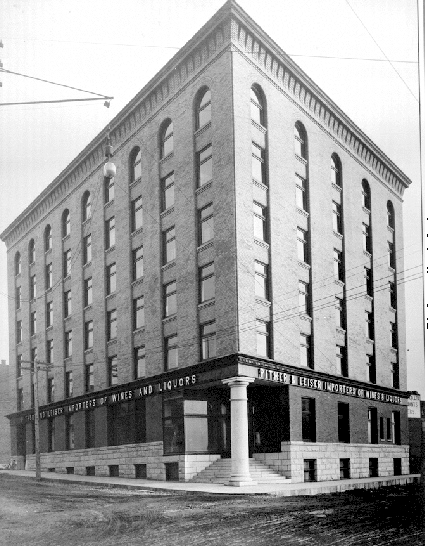Spirits in Victoria
An Inspection of Liquor in the 1860's
The White ProblemAn Inspection of Liquor in the 1860's
PART TWO
From what can be inferred from the police
reports, the behavior of the white population when drinking did not differ
at all from the supposed problem of the Native behavior. From a Sunday
June 28th in 1863 to the police sergeants report book reads:
During the whole of last night there was a great disturbance
in the Colonial Hotel the proprietor did not close the house
until four o'clock in the morning. (53)
During the whole of last night there was a great disturbance
in the Colonial Hotel the proprietor did not close the house
until four o'clock in the morning. (53)
The actions that scared the white population
so much about all of those drunken Indians happened right there in
their own community as well. Prostitution, a vice that was always attributed
to the drunken Indians often occurred in the white establishments. The Commercial
Hotel seemed to be the site of many dark activities, "a prostitute know as
'son of a b____' was in the bar-room of the Commercial Hotel last night for
a considerable time." (54)
Then in a police report record from a few weeks later, " . . . two prostitutes
know as son of a b____ and 'Georgy' go into the Commercial Saloon several
times last night."(55)
Finally, about a week later the police moved on the owner of the Commercial
Saloon and warned him about the clientele of his drinking house. While
it was believed that prostitution was an unpleasant side effect of the Indian
drinking problem, in reality it often did not involve the Natives at all,
most times it was the white men that were in need of the service.

Liquor Importer
- photo courtesy of the BC Archives

Liquor Importer
- photo courtesy of the BC Archives
Another means by which we can discover
just how prevalent alcohol was throughout the 1860's in the white community
is by examining the newspapers that they published. We have already heard
about Amor DeCosmos, one of the papers editors and
his drinking issues.
If we are to look at the British Colonist it is clear that the
most often advertised item was liquor. Most papers throughout the 1860's
contained numerous ads for alcohol, drinking establishments and importers
of alcohol.
The March 24th 1866 edition of the British Colonis t ran ads for: Blood, Wolfe & Co.'s, The Lion Brewery Tap, Miner's Exchange, The 'Grotto', Island Hotel Concert Rooms and the Bull's Head Tavern. (56) All of these establishments were servers of liquor and the audience that they were advertising to were not the Indians,( since they probably would not have read the Colonist.) Another interesting bit of advertising in the papers was the frequency of ads for the Dinneford's Fluid Magnesia which was useful for a great number of illnesses, but the one that is always referenced in bold letters is gout. (57) Gout has many causes , but it often occurs due to the effects of excessive drinking. (58) Advertisements for such products meant that there had have been a need for them, if gout was one of the predominant conditions plaguing the population, than we can assume that there was excessive drinking taking place.
The intention of this section was to demonstrate that although much of the discourse of the 1860's on drinking focused on the Indians, it was not exclusively their problem. The population of whites were drinking just as much and had many problems of their own. Quite a few of the issues about the "drunken Indians" were issues that the white population created or was part of themselves. The drinking problem was one that existed in all walks of life and in all sections of Victoria. The fact that the government and HBC officials felt that liquor was something that they needed to control suggests more about the colonial attitude than it does about the Natives that were drinking.
To learn read some of my reflections about Spirits in Victoria and its
creation click . . .here .
The March 24th 1866 edition of the British Colonis t ran ads for: Blood, Wolfe & Co.'s, The Lion Brewery Tap, Miner's Exchange, The 'Grotto', Island Hotel Concert Rooms and the Bull's Head Tavern. (56) All of these establishments were servers of liquor and the audience that they were advertising to were not the Indians,( since they probably would not have read the Colonist.) Another interesting bit of advertising in the papers was the frequency of ads for the Dinneford's Fluid Magnesia which was useful for a great number of illnesses, but the one that is always referenced in bold letters is gout. (57) Gout has many causes , but it often occurs due to the effects of excessive drinking. (58) Advertisements for such products meant that there had have been a need for them, if gout was one of the predominant conditions plaguing the population, than we can assume that there was excessive drinking taking place.
The intention of this section was to demonstrate that although much of the discourse of the 1860's on drinking focused on the Indians, it was not exclusively their problem. The population of whites were drinking just as much and had many problems of their own. Quite a few of the issues about the "drunken Indians" were issues that the white population created or was part of themselves. The drinking problem was one that existed in all walks of life and in all sections of Victoria. The fact that the government and HBC officials felt that liquor was something that they needed to control suggests more about the colonial attitude than it does about the Natives that were drinking.
To learn read some of my reflections about Spirits in Victoria and its
creation click . . .here .